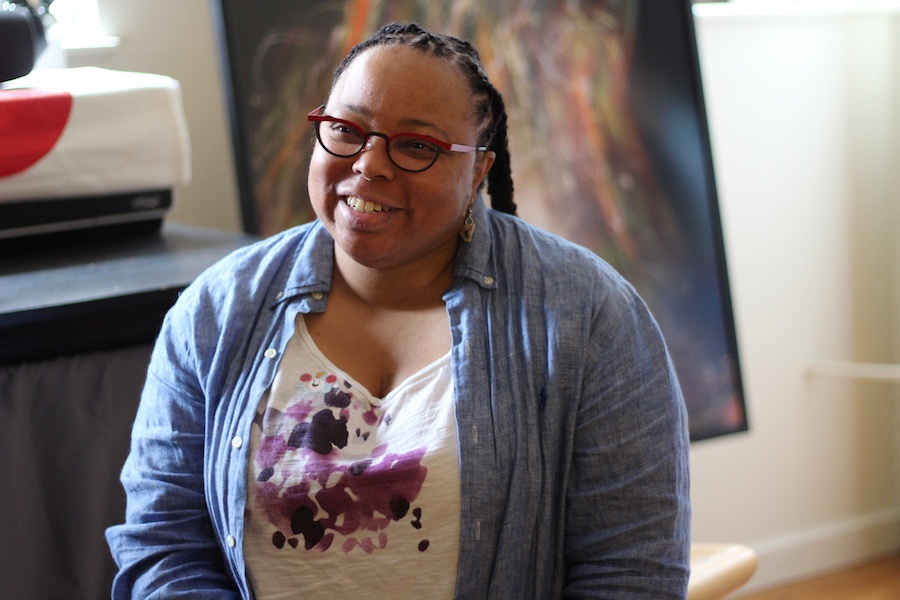
Photography | Arts & Culture | Visual Arts | Studio Visits
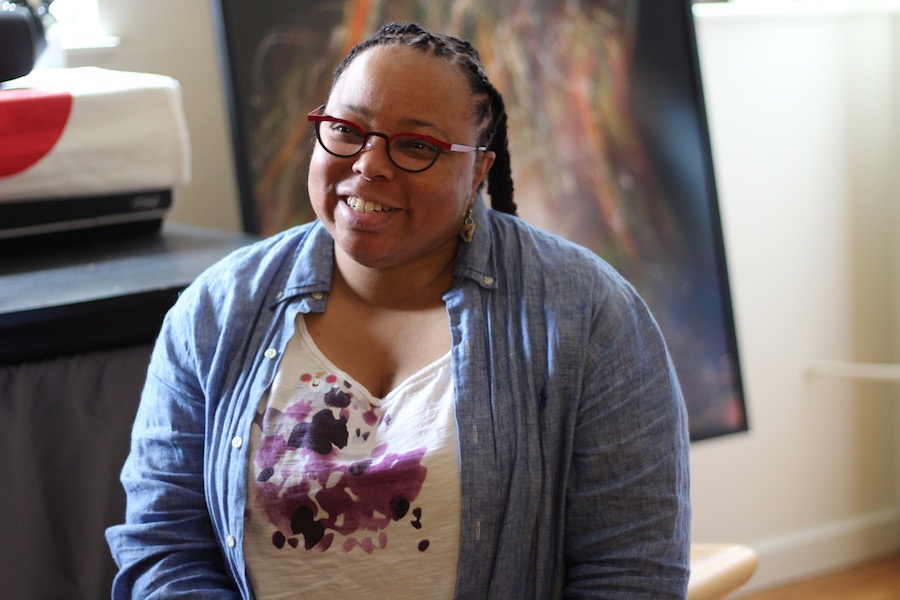
| Kim Weston at City-Wide Open Studios in 2018. Lucy Gellman File Photo. |
Stand at the threshold of Kim Weston’s studio, and you'll notice that every square inch of space is occupied. On a large table, squat jars of paint are arranged neatly, a rainbow of color waiting to be unleashed. Printouts and photos surround her desk, a workspace by the window. Large photographs beckon from all walls: long exposures that look as if they are giving off sparks and rolling out bolts of dark satin. Only when one steps closer does that blue come across as the New England sky.
Weston, a photographer who has worked in Erector Square since 2014, is heading into 2020 with new work, new exhibitions, and a new teaching position at the Educational Center for the Arts. In a recent studio visit that spanned personal history to her current work, she spoke about how she’s gotten there and what she wants to do next.
“I’d like to do more for the community here in New Haven,” she said. “This is my home now, and I’m raising my kids here, and there’s not a lot for them to go to.”
Weston was born in Philadelphia, and had a grounding in art from the very beginning. As a young kid, she remembered watching her dad design cakes in the sugared, warm air of a local bakery. After her parents split, she spent years traveling between New York City and South Carolina, where her grandparents lived with her aunts and uncles. Her family members were sharecroppers, and she spent summers in their tobacco field, removing the secondary stems on the plants in a process known as suckering.
From them, she started learning bits and pieces of a history of erasure. Family members recounted walking away from Native ancestry, “because it was easier to be considered Black.”
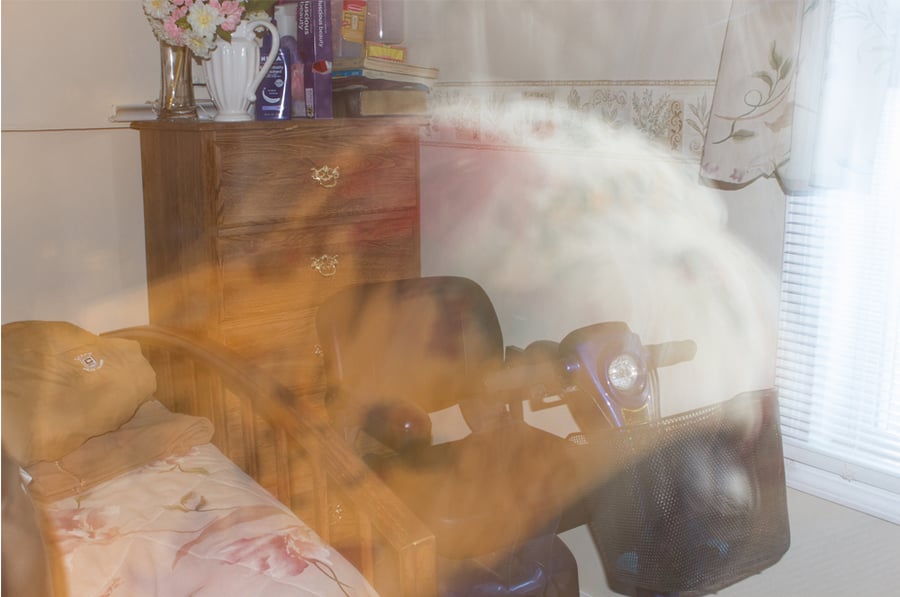
| One of the ghostly images from Weston's Seen Unseen, which she exhibited in 2014 in New York. She got the image when she went into her grandmother's room after her death. Kim Weston Photo. |
Those early years gave way to what she calls her first photographic memories: making mud pies with her aunt beneath the high wood beams of a barn, watching her grandmother move gracefully through the family home, eating ice cream as her payment for suckering at the end of every summer. Even then, she said, she knew she wanted to be an artist.
“It was something that I couldn’t get enough of,” she said. “Very early on, my mother said that she couldn’t keep pieces of paper around me because I would draw on everything. I knew early on that I enjoyed it.”
When Weston was a teenager, her mom enrolled her in the then-nascent Jamaica Center for Arts & Learning not far from where they were living in Queens. Her first teacher was the portrait photographer Larry Brown, known for his photographs of Black Americans in their homes and neighborhoods. Weston was transfixed from the first moment she saw his work: she had never seen people who looked like her taking photographs of other people who looked like her.
He gave her a Canon AE-1 to try shooting on, “and that was it.” By the time she was 15, she was working in his darkroom, mastering the alchemy of chemical baths, slow exposures, and pages still dripping liquid as they dried.
“There was something very beautiful about watching an image appear before your eyes,” she said. “I guess he felt as if I was a good kid, and I was a good photographer, and he wanted to nourish that. He became a mentor to me.”
Through Brown, Weston’s artistic world cracked open. In her studies at the Center for Arts & Learning, she met and was mentored by the photographer Eugene Adams, then learned from artists-in-residence that included Lorna Simpson, Carrie Mae Weems, Elizabeth Catlett and a young Dawoud Bey. She watched as curators including MacArthur grantee Kellie Jones and Thelma Golden, who is now at the Studio Museum in Harlem, navigated the art world. Each of them mesmerized her as they gave her one more lens through which to see her own body and her own Blackness.
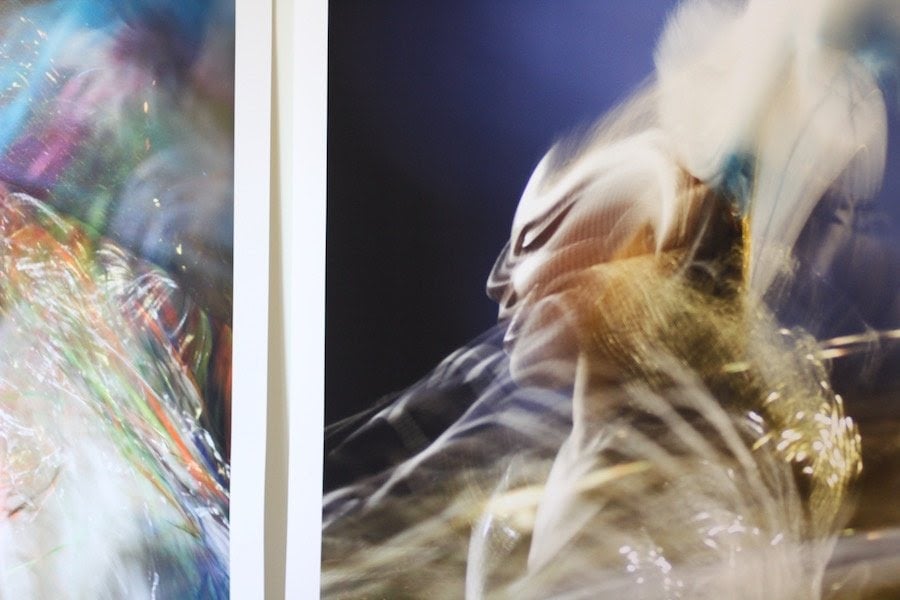
| During City-Wide Open Studio a year ago, Weston held an installation of current work at her Erector Square studio. The photographs are long exposures that she has taken at powwows. Lucy Gellman Photo with permission from the artist. |
“That was the most amazing thing,” she said. “All that stuff played a huge role in how I saw my community. It wasn’t all dreary, you know? I grew up during the time of crack, and so that was huge when I was a young person and the people in the community were doing a lot of drugs and the men were going to jail. It was a lot. Seeing all those artists come through … it was like the biggest thing ever.”
In the late 1980s, Weston grew her studies in photography at Cooper Union, focusing on portraits of Black men in her undergraduate work. When she wasn’t in the darkroom, she worked on installations in the school’s gallery and offices, once placing her own self-portrait among those of white men that dominated university buildings. Her background launched her into teaching and commercial photography, where she worked for the music industry and took gigs at the Harlem-based Children's Art Carnival and Harem School of the Arts.
Then, after a divorce in the late 1990s, she moved to Philadelphia. For the first time in years, Weston put her camera down and started painting. She started to turn out abstract canvases, displaying them at craft fairs around New England. She reconnected with one of her sisters, through whom she met her now-wife Laura Fuller-Weston. Together, the two started going to powwows, which Fuller-Weston had grown up attending to celebrate her Seminole heritage.
For Weston, it was a revelation. While the artist is both Black and Mohawk, she had grown up hiding that second identity because she’d watched her family do the same.
“For me, what makes me Native is the ability to share the traditions,” she said. “Standing up for the people. The same way I stood up for Black men, I want to stand up for Native people.”
Weston started bringing her camera to powwows, taking pictures of both the events themselves and everything that happened behind the scenes. As she shot, she noticed a few of what she now calls “ghostly images”—a fogged or blurring frame, or shape that she didn’t remember seeing—but thought nothing of them. She would develop them, shrug at the film, and file them away in a drawer.
And then seven years ago, her approach was rocked by the spirit world. Weston has sarcoidosis, a disease that works against the body much like lupus does. After brain surgery in 2012, she stopped breathing in the hospital. She was, she said, medically dead. In the moments before she started breathing again, she said she can remember having visions of people standing around her bed, giving her a choice to stay with her wife or to go with them. She stayed.
“I realized that life was really short, and I wanted more,” she said. She enrolled in graduate coursework at the International Center for Photography-Bard in New York, frustrated when teachers and fellow criticized her photographs. She held a major solo show there in 2014, paying tribute to the extended family that had helped raise her decades before. In it, she chronicled not only her grandmother's dedication to her family and her home, but also the loss of family land that came at the hands of corporate farming.
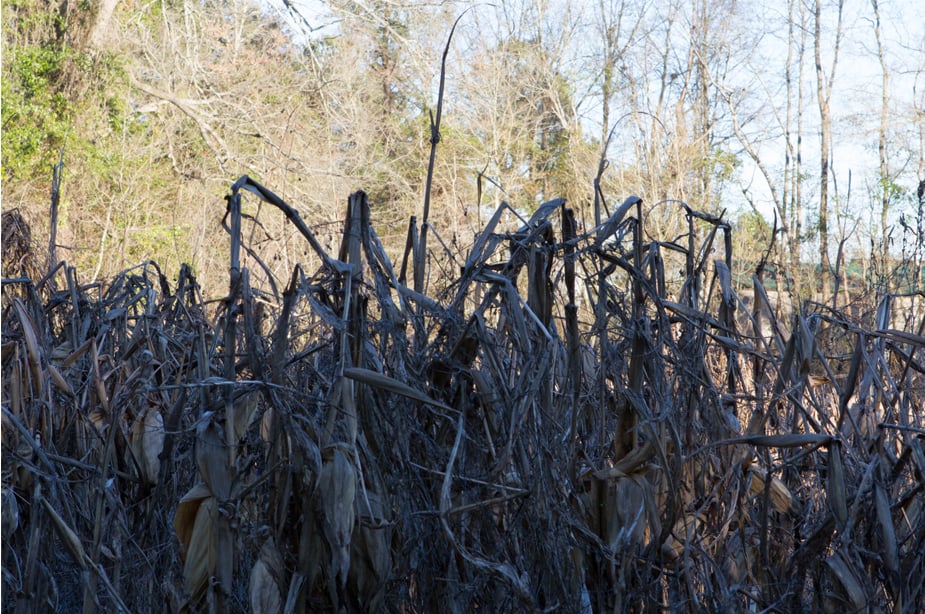
| One of the family history images from Weston's Seen Unseen, which she exhibited in 2014 in New York. Kim Weston Photo. |
Meanwhile, something about her images was still stuck. Her classmates nicknamed her the “National Geographic photographer,” which was meant as a sort of epithet. At powwows, the ghostly images kept showing up, and she kept thinking nothing of them. They were just flukes, she thought.
And then one day she decided to abandon everything she understood and try something new.
She and Fuller-Weston had brought their kids to a powwow, where she was getting ready to photograph. Behind her, a photographer asked if he could use her spot to get the image he wanted. Weston turned around and studied him: he had the same camera that she did, and was using the same lens too. He would be getting exactly the same shot. She looked around the space, and realized that there were a lot of documentary photographers that would be getting the same shot.
“I thought, what am I doing here?” she recalled. “It inspired me to do something different.”
She started playing with the exposures, getting images that looked like the ghostly ones she had kept at home. Bursts of color gave way to multiple faces, split and fading in the same arcs of darkness and light. Arms rose in blurs of electric white and yellow. The more she practiced, the more the images “started having more spirit to them.” For the artist, who also dances in powwows, something clicked.
“When I dance, I get to connect with the great spirit in myself, and the community around me,” she said. “I feel the earth on my feet. I hear the drum through my ears. And I feel the people in my body. And so I started shooting in a way that was different.”
Weston started shooting from the ground, channeling as much of the dancer’s spirit as she could read from a crouch or a kneel beside heartbeat-like drums. The images became the backbone of her work today, which has included installations that bridge the her Native and Black, Southern spirit worlds. A few years ago, she started adding blood-red prayer bundles meant to spread a message of tribute and memory. Each bundle contains a small amount of tobacco, wrapped tightly in red fabric.
In the first few months of next year, she will open shows at the Kehler Liddell Gallery in New Haven and deCordova Sculpture Park and Museum in Massachusetts among others. In advance of the second project, a group show titled Visionary New England, she is assembling 10,000 prayer bundles to represent 10,000 missing and murdered indigenous women. She said she hopes to do a similar installation for missing and murdered Black women in the coming year.
“No one’s talking about these two different cultures that are having the exact same problem,” she said. “It’s like, there’s all this news, and it’s news about Trump. But there’s no news about these horrific numbers that these women are disappearing in. That’s my goal. That goes back to having some purpose and having some meaning.”
She also wants to go into the next decade as a cheerleader for the community. Echoing arts advocates around the city, she noted the need for a creative hub that is completely open to youth, whether or not they can afford tuition.
“I think New Haven deserves to have a place like that,” she said. “It’s big enough. The demographics here demand it. There’s a huge Hispanic population. There’s a huge Black population. And the white population here would also benefit from the program if their children all went together. Because when you mix cultures, when you mix experiences, you get educated on something that’s different from you. And everyone wins.”

